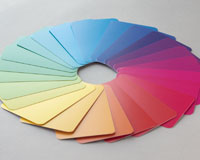for people who design things, then print them
A Printer’s Devil
Ball State University Article
This piece was written by a Ball State University student and member of the Book Arts Collaborative in Muncie, Indiana. They asked if they could post some articles here. I normally say no but after reading I was more than happy to. They are well worth the read. Scroll to the bottom of the page to see the full list of articles.
A Printer’s Devil: A 21st-Century Journalist Living in the Age of the Press
By Kayla Bickham
After the emergence of the printing press in the mid-1400s, learning to print text such as books, pamphlets or postcards meant aspiring printers typically served seven year apprenticeships under a master printer. They were referred to as “devils” since they caused so much trouble in the “chapel” of the print room.
To be a printer’s devil at Book Arts Collaborative, a Ball State University cottage industry dedicated to book binding and letterpress printing, is to be one of nine other 21st-century journalism majors who has mastered the computer and now takes on the task of learning a centuries-old trade.
I, being one of the nine, am set apart from the rest of the devils because I am not a master of the computer. Being new to the journalism major has allowed for me to come into this class with a completely clean page. There is no need to adapt to this new art form of journalism because this is, so far, the only one I know.
My classmates who write feature pieces for our university’s magazine and inverted-pyramid stories for our newspaper, now compose text through the arrangement of type that has left their computer screens and found its way to a composing stick. They are replacing one inch margins to center their articles with furniture in a chase to position their type. Leading in between each sentence takes the place of the enter key on a keyboard. The right font is not found in a drop-down menu, but stocked away in a galley tray. Google images now takes the form of an old wooden drawer where we find the best cut fitting for our text.
The actual act of printing their piece is completely unfamiliar territory. The simple task of left clicking a mouse to choose between printing in color or black and white requires more steps here at the shop. It now entails grazing the top of a pot of ink with a spatula to coat the clamshell printer’s plate with the desired color. A piece with more than one color means wiping the press clean and doing the exact same steps ... AGAIN.
Considering how the pressmen shaped who I am as a journalist today is absent from my mind because it is actively shaping me at this moment. I am growing alongside the evolution of the printing press. I am allowing it to mold me into the journalist I will someday be.
As a journalist, I will type each word with caution and attentiveness being mindful of how careful I once had to be when composing small type. I will write sentences in a simple manner, leaving out lengthy and drawn out details as I recall how difficult it was to place just one row of type. I will refrain from wasting paper as I think back to how many times I had to physically turn the wheel of a press to print on each sheet of newspaper. I will be a journalist not only with skill, but with an appreciation of my craft.
Journalists of the 1970s worked with the press up until it was replaced by the computer. My fellow journalists of today began after the printing press had already transformed into this new world of technology. But the press is not necessarily history--this is my present. Instead of constantly comparing this printing of the past to technology of today, I have the luxury of living in both worlds.
To take this class means that I can reside in a world that my classmates are merely visiting. They are taking a break from their new technological world of journalism and entering foreign ground. For me, however, this is my native land. This odd jargon is my native tongue. My journalistic journey has just been born and starts here where I am known as a printer’s devil.
Ball State University & The Book Arts Collaborative
This piece was written by a Ball State University student and member of the Book Arts Collaborative in Muncie, Indiana. The Book Arts Collaborative is dedicated to preserving and promoting the apprentice-taught skills of letterpress printing and book binding through community interaction. It's not just what we make that matters, but how we learn from one another to make it happen.
All Student Articles...
Swatchos

Choose Colours With A Deck Of Cards
A box of cards for choosing colours and making colour schemes.
- 130 Cards
- CMYK Values
- RGB Values
- 900 Colours
- Millions of combinations
£36 / $47 / €43
Brought to you by
Swatchos
Pick Colours With A Deck Of Cards
A box of 130 cards for playing with colour. For digital or print creatives. RGB and CMYK values. Millions of combinations.




